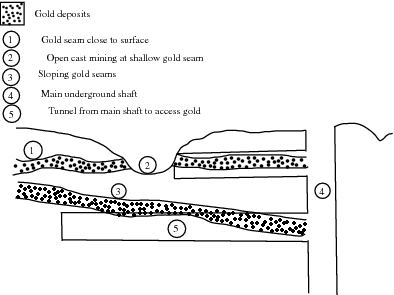| << Chapter < Page | Chapter >> Page > |
Gold was discovered in South Africa in the late 1800's and since then has played a very important role in South Africa's history and economy . Its discovery brought many foreigners into South Africa, who were lured by the promises of wealth. They set up small mining villages, which later grew into larger settlements, towns and cities. One of the first of these settlements was the beginning of present-day Johannesburg, also known as 'Egoli' or 'Place of Gold'.
Most of South Africa's gold is concentrated in the 'Golden Arc', which stretches from Johannesburg to Welkom. Geologists believe that, millions of years ago, this area was a massive inland lake. Rivers feeding into this lake brought sand, silt, pebbles and fine particles of gold and deposited them over a long period of time. Eventually these deposits accumulated and became compacted to form gold-bearing sedimentary rock or gold reefs . It is because of this complex, but unique, set of circumstances that South Africa's gold deposits are so concentrated in that area. In other countries like Zimbabwe, gold occurs in smaller 'pockets', which are scattered over a much greater area.
A number of different techniques can be used to mine gold. The three most common methods in South Africa are panning , open cast and shaft mining.

For every ton of ore that is mined, only a very small amount of gold is extracted. A number of different methods can be used to separate gold from its ore, but one of the more common methods is called gold cyanidation .
In the process of gold cyanidation, the ore is crushed and then cyanide (CN ) solution is added so that the gold particles are chemically dissolved from the ore. In this step of the process, gold is oxidised. Zinc dust is then added to the cyanide solution. The zinc takes the place of the gold, so that the gold is precipitated out of the solution. This process is shown in [link] .

Notification Switch
Would you like to follow the 'Siyavula textbooks: grade 11 physical science' conversation and receive update notifications?